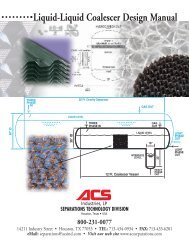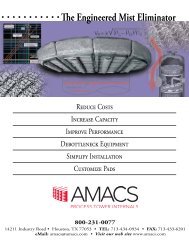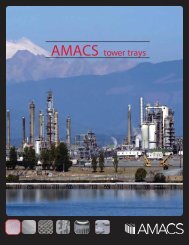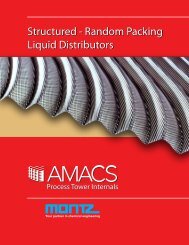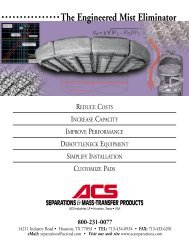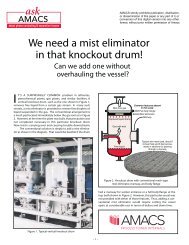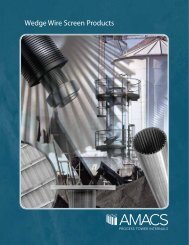Mesh and Vane Mist Eliminator Brochure - AMACS Process Tower ...
Mesh and Vane Mist Eliminator Brochure - AMACS Process Tower ...
Mesh and Vane Mist Eliminator Brochure - AMACS Process Tower ...
You also want an ePaper? Increase the reach of your titles
YUMPU automatically turns print PDFs into web optimized ePapers that Google loves.
Consider a droplet approaching a mesh filament of<br />
much larger diameter as shown in Figure 4b. The<br />
more dense the droplet relative to the gas, the larger<br />
the droplet relative to the filament, <strong>and</strong> the higher the<br />
gas velocity, the more likely it is that the droplet will<br />
strike the filament. If the velocity is too low, or the<br />
droplet too small or too light compared to the gas, the<br />
droplet will simply flow around the filament with the<br />
gas. If the velocity is too high, liquid clinging to the filaments<br />
will be re-entrained, mostly as larger droplets,<br />
<strong>and</strong> carried away by the gas. Re-entrainment is also<br />
promoted by low relative liquid density (making it easier<br />
for the gas to pick up a droplet) <strong>and</strong> low liquid surface<br />
tension (as less energy is required to break up a<br />
film or droplet). The engineered wire mesh mist eliminator<br />
may remove 99.9% of particles 2 µm <strong>and</strong><br />
greater diameter. Figure 5 shows a typical removal<br />
efficiency vs droplet size distribution for a wire mesh<br />
mist eliminator.<br />
FIGURE 5<br />
SEPARATION EFFICIENCY FOR VARIOUS<br />
DROPLET SIZES IN A TYPICAL<br />
WIRE MESH MIST ELIMINATOR<br />
momentum, tend to move<br />
in straight lines. By studying<br />
this figure, it is easy to<br />
underst<strong>and</strong> why in the<br />
design equations to follow<br />
the removal efficiency is<br />
directly proportional to the<br />
difference in densities of<br />
the liquid droplet <strong>and</strong> carrying<br />
gas. With each change<br />
in direction of the gas,<br />
some droplets collide with<br />
the surface <strong>and</strong> adhere,<br />
eventually coalescing into<br />
larger droplets which then<br />
drain by gravity. Properly<br />
designed vane mist eliminators<br />
can remove 99% of<br />
particles as low as 10 µm<br />
in diameter, especially at<br />
lower pressures.<br />
Figure 7 illustrates typical<br />
wire mesh <strong>and</strong> Plate-Pak<br />
vane mist eliminators,<br />
Stream of<br />
gas curves<br />
back <strong>and</strong> forth<br />
between plates<br />
FIGURE 6<br />
Droplet<br />
capture in a<br />
Plate-Pak TM unit<br />
At each<br />
curve,<br />
liquid<br />
droplets<br />
strike<br />
plates<br />
<strong>and</strong> Figure 8 shows some typical performance curves<br />
for both mesh <strong>and</strong> vane mist eliminators.<br />
FIGURE 7<br />
Typical <strong>AMACS</strong><br />
<strong>Mist</strong> <strong>Eliminator</strong>s<br />
<strong>Mesh</strong> pad Style 4CA<br />
Droplets ~20 µm <strong>and</strong> greater are primarily collected<br />
by means of Inertial Impaction whereby the target is<br />
directly in the path of the streamline, as shown in<br />
Figure 4c. Figure 6 depicts a profile of the ACS<br />
Plate-Pak vane. The entrained droplets, due to their<br />
Plate-Pak unit<br />
THE ENGINEERED MIST ELIMINATOR 3<br />
TEL:<br />
800-231-0077 • FAX: 713-433-6201 • WEB: www.amacs.com • EMAIL: amacs@amacs.com



